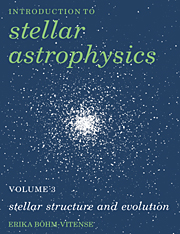Book contents
- Frontmatter
- Contents
- Preface
- 1 Introduction
- 2 Hydrostatic equilibrium
- 3 Thermal equilibrium
- 4 The opacities
- 5 Convective instability
- 6 Theory of convective energy transport
- 7 Depths of the outer convection zones
- 8 Energy generation in stars
- 9 Basic stellar structure equations
- 10 Homologous stars in radiative equilibrium
- 11 Influence of convection zones on stellar structure
- 12 Calculation of stellar models
- 13 Models for main sequence stars
- 14 Evolution of low mass stars
- 15 Evolution of massive stars
- 16 Late stages of stellar evolution
- 17 Observational tests of stellar evolution theory
- 18 Pulsating stars
- 19 The Cepheid mass problem
- 20 Star formation
- Appendix Radiative energy transport in stars
- Problems
- References
- Index
Preface
Published online by Cambridge University Press: 08 January 2010
- Frontmatter
- Contents
- Preface
- 1 Introduction
- 2 Hydrostatic equilibrium
- 3 Thermal equilibrium
- 4 The opacities
- 5 Convective instability
- 6 Theory of convective energy transport
- 7 Depths of the outer convection zones
- 8 Energy generation in stars
- 9 Basic stellar structure equations
- 10 Homologous stars in radiative equilibrium
- 11 Influence of convection zones on stellar structure
- 12 Calculation of stellar models
- 13 Models for main sequence stars
- 14 Evolution of low mass stars
- 15 Evolution of massive stars
- 16 Late stages of stellar evolution
- 17 Observational tests of stellar evolution theory
- 18 Pulsating stars
- 19 The Cepheid mass problem
- 20 Star formation
- Appendix Radiative energy transport in stars
- Problems
- References
- Index
Summary
In Volume 3 of Introduction to Stellar Astrophysics we will discuss the internal structure and the evolution of stars.
Many astronomers feel that stellar structure and evolution is now completely understood and that further studies will not contribute essential knowledge. It is felt that much more is to be gained by the study of extragalactic objects, particularly the study of cosmology. So why write this series of textbooks on stellar astrophysics?
We would like to emphasize that 97 per cent of the luminous matter in our Galaxy and in most other galaxies is in stars. Unless we understand thoroughly the light emission of the stars, as well as their evolution and their contribution to the chemical evolution of the galaxies, we cannot correctly interpret the light we receive from external galaxies. Without this knowledge our cosmological derivations will be without a solid foundation and might well be wrong. The ages currently derived for globular clusters are larger than the age of the universe derived from cosmological expansion. Which is wrong, the Hubble constant or the ages of the globular clusters? We only want to point out that there are still open problems which might well indicate that we are still missing some important physical processes in our stellar evolution theory. It is important to emphasize these problems so that we keep thinking about them instead of ignoring them. We might waste a lot of effort and money if we build a cosmological structure on uncertain foundations.
The light we receive from external galaxies has contributions from stars of all ages and masses and possibly very different chemical abundances.
- Type
- Chapter
- Information
- Introduction to Stellar Astrophysics , pp. xiii - xviPublisher: Cambridge University PressPrint publication year: 1992

